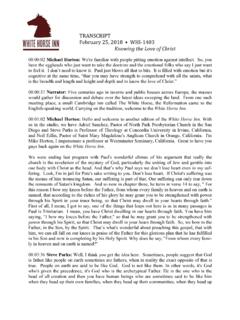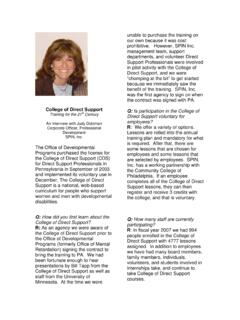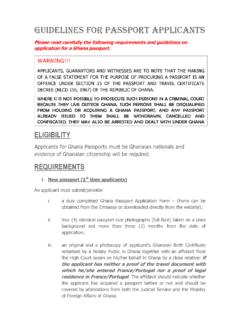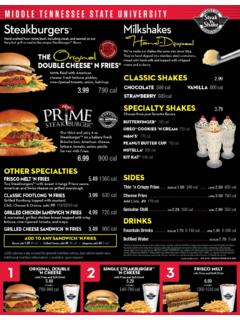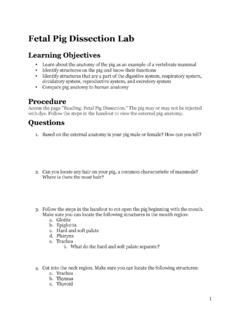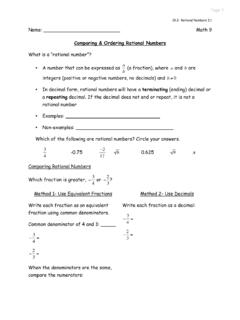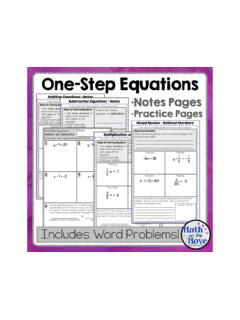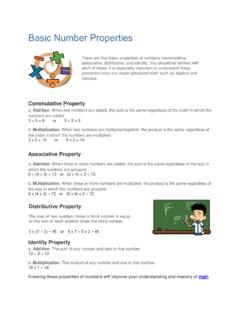Transcription of Textbook-for-Phoenix-College -MAT091---Introductory ...
1 Integers and rational and rational NumbersLearning Objectives Graph and compare integers. Classify and order rational numbers. Find opposites of numbers. Find absolute values. Compare fractions to determine which is and Compare IntegersIntegersare the counting numbers(1,2, ), the negative counting numbers( 1, 2, )and zero. There arean infinite number of integers. Examples of integers are 0,3,76, 2, 11,995,..and you may know them by thenamewhole numbers. When we represent integers on the number line they fall exactly on the whole 1 Compare the numbers2and 5 First, we will plot the two numbers on a number can compare integers by noting which is thegreatestand which is theleast.
2 Thegreatestnumber is farthest tothe right, and theleastis farthest to the the diagram above, we can see that 2 is farther to the right on the number line than 5, so we say that 2 is greaterthan 5. We use the symbol > to mean greater than .Solution2> 5 Example 2A frog is sitting perfectly on top of number7on a number line. The frog jumps randomly to the left or right, but alwaysjumps a distance of the set of numbers that the frog may land on, and list all the possibilities forthe frog s position after will graph the frog s position, and also indicate what a jump of 2 looks like. We see that one possibility is thatthe frog lands on 5.
3 Another possibility is that it lands on 9. It is clear that the frog will always land on one jump the frog could be on either the 9 or the 5 (but not on the 7). After two jumps the frog could be on 11,7 or 3. By counting the number of times the frog jumps to the right or left, we may determine where the frog 1. Real Numbers OperationsAfter five jumps, there are many possible locations for the frog. There is a systematic way to determine the possiblelocations by how many times the frog jumped right, and by how many times the frog jumped jumps rightlocation=7+(5 2) =17 RRRRL=4 jumps right, 1 jump leftlocation=7+(3 2) =13 RRRLL=3 jumps right, 2 jumps leftlocation=7+(1 2) =9 RRLLL=2 jumps right, 3 jumps leftlocation=7 (1 2) =5 RLLLL=1 jump right, 4 jumps leftlocation=7 (3 2) =1 LLLLL=5 jumps leftlocation=7 (5 2) = 3 These are the possible locations of the frog after exactly five jumps.
4 Notice that the order does not matter: threejumps right, one left and one right is the same as four jumps to the right and one to the rational NumbersWhen we divide an integer by another integer (notzero) we get what we call arational is called thisbecause it is theratioof one number to another. For example, if we divide one integeraby a second integerbtherational number we get isab, provided thatbis not zero. When we write a rational number like this, the top numberis called thenumerator. The bottom number is called thedenominator. You can think of the rational number as afraction of a cake.
5 If you cut the cake intobslices, your share isaof those example, when we see the rational number12, we imagine cutting the cake into two parts. Our share is one ofthose parts. Visually, the rational number12looks like the rational number34, we cut the cake into four parts and our share is three of those parts. Visually, the rationalnumber34looks like rational number910represents nine slices of a cake that has been cut into ten pieces. Visually, the rationalnumber910looks like fractionsare rational numbers where the numerator (the number on the top) is less than the denominator(the number on the bottom).
6 A proper fraction represents a number less than one. With a proper fraction you alwaysend up with less than a whole cake!Improper fractionsare rational numbers where the numerator is greater than the denominator. Improper fractionscan be rewritten as a mixed number an integer plus a proper fraction. An improper fraction represents a numbergreater than fractionsare two fractions that give the same numerical value when evaluated. For example, look at avisual representation of the rational Integers and rational can see that the shaded region is identical in size to that of the rational number one-half12.
7 We can write outthe prime factors of both the numerator and the denominator and cancel matching factors that appear in both thenumeratoranddenominator.(24)=( 2 1 2 2 1)We then re-multiply the remaining factors.(24)=(12)This process is calledreducingthe fraction, or writing the fraction in lowest terms. Reducing a fraction does notchange the value of the fraction. It just simplifies the way we write it. When we have canceled all common factors,we have a fraction in itssimplest 3 Classify and simplify the following rational numbersa)(37)b)(93)c)(5060)a) 3 and 7 are both prime there is no simpler form for this rational number already in its simplest ) 9=3 3 and 3 is prime.
8 We rewrite the fraction as:(93)=( 3 3 1 3 1).9>3 so..Solution93is an improper fraction and simplifies to31or simply ) 50=5 5 2 and 60=5 3 2 2. We rewrite the fraction thus:5060=( 5 5 2 1 5 5 2 2 1).50<60 so..Solution5060is a proper fraction and simplifies rational NumbersOrdering rational numbers is simply a case of arranging numbers in order of increasing value. We write the numberswith the least (most negative) first and the greatest (most positive) 4 Put the following fractions in order from least to greatest:12,34,23 Solution12<23<34 Simple fractions are easy to order we just know, for example, that one-half is greater than one quarter, and that twothirds is bigger than one-half.
9 But how do we compare more complex fractions?With simple fractions, it is easy to order them. Think of the example above. We know that one-half is greater thanone quarter, and we know that two thirds is bigger than one-half. With more complex fractions, however we need tofind a better way to 1. Real Numbers OperationsWhich is greater,37or49?In order to determine this we need to find a way to rewrite the fractions so that we can better compare them. Weknow that we can write equivalent fractions for both of these. If we make the denominators in our equivalentfractions the same, then we can compare them directly.
10 We are looking for the lowest common multiple of each ofthe denominators. This is called finding thelowest common denominator(LCD).The lowest common multiple of 7 and 9 is 63. Our fraction will be represented by a shape divided into 63 time we will use a rectangle cut into 9 by 7=63 pieces:7 divides into 63 nine times so:(37)=99(37)=(2763)Note that multiplying by99is the same as multiplying by 1. Therefore,2763is an equivalent fraction to37. Here it isshown divides into 63 seven times so:(49)=77(49)=(2863)2863is an equivalent fraction to49. Here it is shown writing the fractions over acommon denominatorof 63, you can easily compare them.

